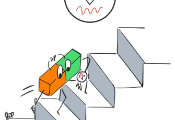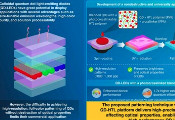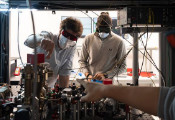Quasiperiodic Materials Enable Robust Quantum Transport Without Energy Gaps
July 11, 2025 -- A new study has overturned conventional wisdom in the world of quantum mechanics, showing that quantum particles can be shuttled across a system in a perfectly precise way, even in the presence of strong disorder that was otherwise believed to hamper the process. This finding could pave the way for more resilient quantum devices and innovative approaches to quantum information processing, a key ingredient of future quantum computers.
In the 1980’s, scientists discovered that systems called “topological pumps” allowed to reliably move a perfectly stable number of quantum particles across space with full control. However, the stability of such topological pumps was believed to rely on a clear separation between occupied and empty energy states, known as an energy gap. This gap was thought to be essential for the remarkable precision observed in these systems.
However, a research team at the Cavendish Laboratory, publishing in PRX Quantum, has shown that the story is much richer.
“Traditionally, physicists believed that some separation between the mobile and immobile energy states was needed in order to protect the delicate flow of quantum states through a topological pump,” said Dr Emmanuel Gottlob, first author of the paper and former PhD Student at the Cavendish Laboratory, where he conducted this research. “These gaps can act as buffers, keeping particles in the required mobile states and preventing disruption from small amounts of external noise or disorder.”
But the new study, focusing on a famously complex one-dimensional lattice called the Aubry-André-Harper model, reveals a different kind of protection; one that goes beyond energy separation and instead relies on the intricate geometry of the system itself.
Unlike typical crystal lattices, the Aubry-André–Harper lattice features a quasiperiodic, or incommensurate, pattern that creates a unique, fractal-like energy spectrum, whose eigenstates can be strongly localised in space.
Even when they introduced an amount of disorder strong enough to “close” the traditional gap that usually protects particle flow, the researchers found that the system still moved exactly the right number of particles every cycle. This precision held up across a wide range of conditions.
According to the researchers, three factors combine to create this robustness: particles become localised due to quasiperiodicity (a phenomenon known as Anderson localization); the lattice’s fractal energy structure restricts unwanted transitions; and the system can be driven fast enough to avoid long-range hops.
“In short, the energy separation is not required anymore,” said Gottlob. “Instead, particles can cross in energy, but the combination of spatial localisation and the unique structure of the quasiperiodic lattice keep the particle count perfectly stable.”
The study’s significance extends beyond theory. The proposed mechanism uses features already available in experimental platforms such as ultracold-atoms in optical lattices, photonic waveguides, and superconducting-qubit arrays. This means these findings could soon be applied to build quantum devices that are far more robust against noise and disorder, facilitating reliable and secure transport of quantum information.
“Topological protection, once thought to rely on energy gaps, might instead be achieved through a clever combination of spatial localisation and lattice design,” said Professor Ulrich Schneider, from the Cavendish Laboratory and senior author of the study. “As the quantum revolution gathers pace, these insights could shape the next generation of noise-resistant quantum technologies.”




































